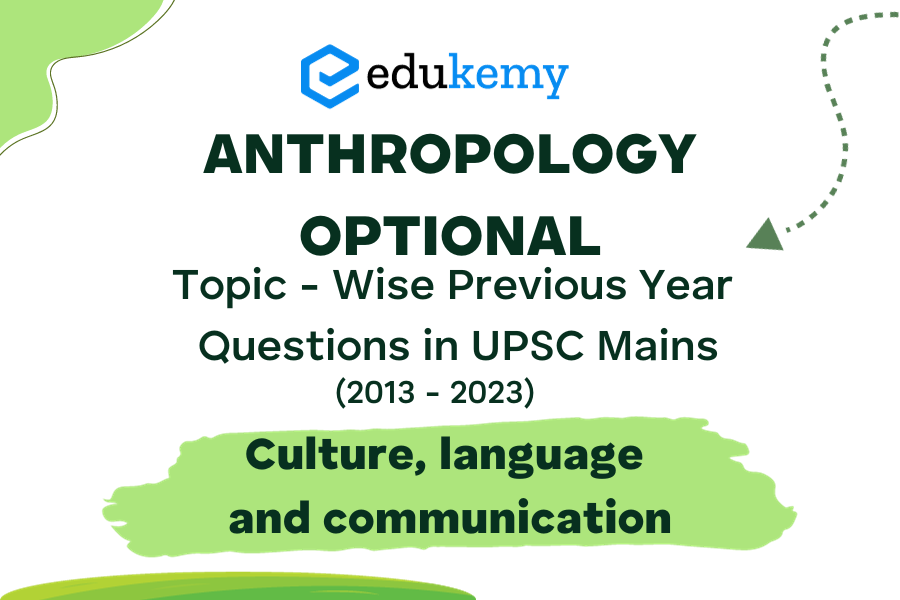
Embarking on the challenging journey of preparing for the UPSC mains examination demands a strategic and comprehensive approach. For aspirants opting for Anthropology as their optional subject, delving into the previous year’s questions becomes not just a practice but a key to unlocking the nuances of the discipline. In this blog series, we turn our focus to the Anthropology optional topic – “Culture, language and communication,” spanning the years 2013 to 2023. This section, often regarded as the heart of Anthropology, explores the intricate web of human societies, unraveling the threads that bind individuals through culture, language, and the art of communication. By meticulously dissecting the past decade’s questions, aspirants can gain valuable insights into the examination patterns, pinpoint the recurring themes, and tailor their preparation to align with the evolving demands of the UPSC Anthropology syllabus.
In the upcoming paragraphs, we will dissect the patterns, trends, and evolving nuances evident in the questions posed by the UPSC over the past decade. This exploration aims not only to provide a roadmap for aspirants but also to foster a deeper understanding of the multifaceted aspects of culture, language, and communication in the realm of Anthropology. As we navigate through the questions, we will unravel the significance of cultural diversity, the dynamics of linguistic evolution, and the pivotal role communication plays in shaping societies.
Contents
- 1 Culture, language and communication – Previous Year Questions (UPSC CSE Mains Anthropology Optional)
- 2 Frequently Asked Questions (FAQs)
- 2.1 Q: What role does culture play in shaping language and communication?
- 2.2 Q: How does language act as a carrier of cultural identity?
- 2.3 Q: In what ways do globalizations and modernization impact traditional communication patterns?
- 2.4 Q: How do non-verbal cues contribute to cross-cultural communication?
- 2.5 Q: What role do linguistic minorities play in preserving linguistic diversity?
- 3 In case you still have your doubts, contact us on 9811333901.
Culture, language and communication – Previous Year Questions (UPSC CSE Mains Anthropology Optional)
1. Write a note on Language and culture (1993)
2. State the theories regarding the origin of spoken languages in human societies both from biological and cultural points of view. (2010)
3. Write a note in 150 words on Nonverbal communication.(2017)
4. Critically examine that the structure and content of language are influenced by culture.(2018)
5. Write notes on Sapir-Whorf hypothesis in about 150 words.(2020)
6. Explain how variations in language usage is related to social inequality.(2020)
Frequently Asked Questions (FAQs)
Q: What role does culture play in shaping language and communication?
Culture significantly influences language and communication patterns. It not only shapes the vocabulary and expressions within a particular community but also defines the acceptable norms and behaviors in communication. Understanding the interplay between culture and language is crucial for effective communication, especially in diverse and multicultural settings.
Q: How does language act as a carrier of cultural identity?
Language serves as a powerful tool for preserving and transmitting cultural identity. Through language, communities express their unique values, traditions, and historical narratives. Examining the link between language and cultural identity helps in comprehending the richness and diversity of human societies and provides insights into the social fabric of different communities.
Q: In what ways do globalizations and modernization impact traditional communication patterns?
Globalization and modernization bring about significant changes in communication dynamics. Traditional communication methods rooted in local cultures may face challenges in adapting to the fast-paced globalized world. Exploring the effects of globalization on language and communication helps in understanding the evolving nature of interpersonal and intercultural exchanges.
Q: How do non-verbal cues contribute to cross-cultural communication?
Non-verbal communication, including gestures, facial expressions, and body language, plays a crucial role in cross-cultural interactions. Different cultures may interpret non-verbal cues differently, leading to potential misunderstandings. Recognizing and interpreting these cues are essential for fostering effective communication and building rapport across diverse cultural contexts.
Q: What role do linguistic minorities play in preserving linguistic diversity?
Linguistic diversity is a vital aspect of cultural richness. Linguistic minorities often act as guardians of unique languages, contributing to the overall tapestry of human communication. Examining the challenges faced by linguistic minorities and the measures taken to preserve their languages provides valuable insights into the broader issues of language sustainability and cultural heritage.
In case you still have your doubts, contact us on 9811333901.
For UPSC Prelims Resources, Click here
For Daily Updates and Study Material:
Join our Telegram Channel – Edukemy for IAS
- 1. Learn through Videos – here
- 2. Be Exam Ready by Practicing Daily MCQs – here
- 3. Daily Newsletter – Get all your Current Affairs Covered – here
- 4. Mains Answer Writing Practice – here

